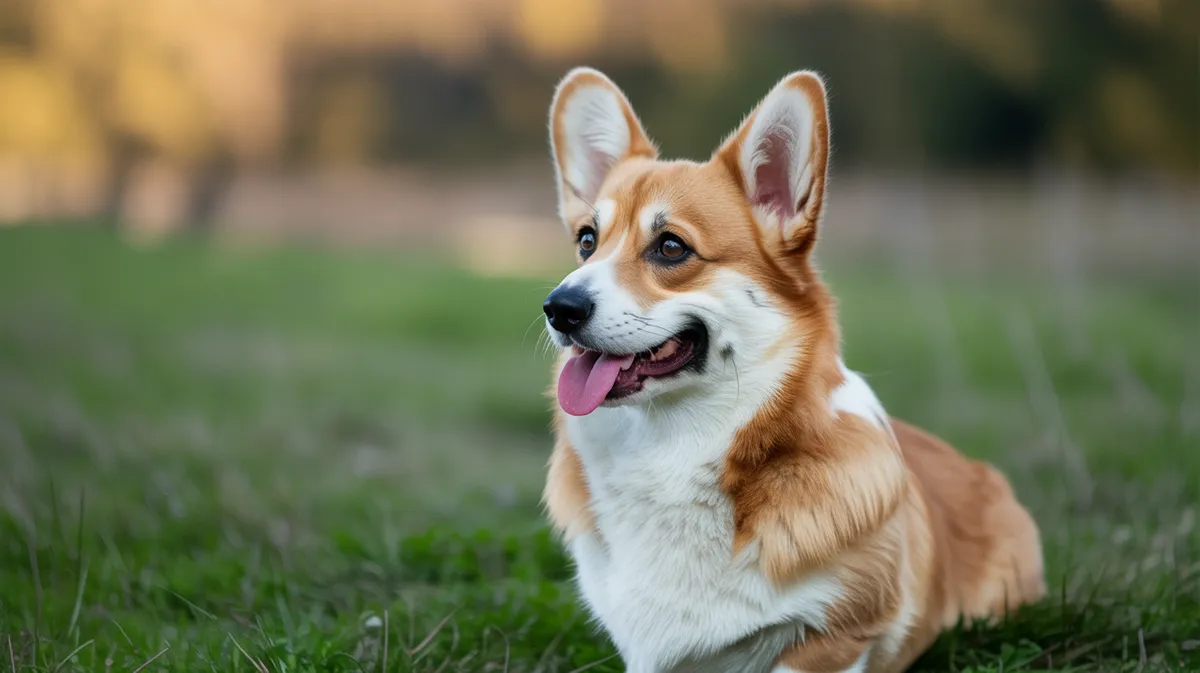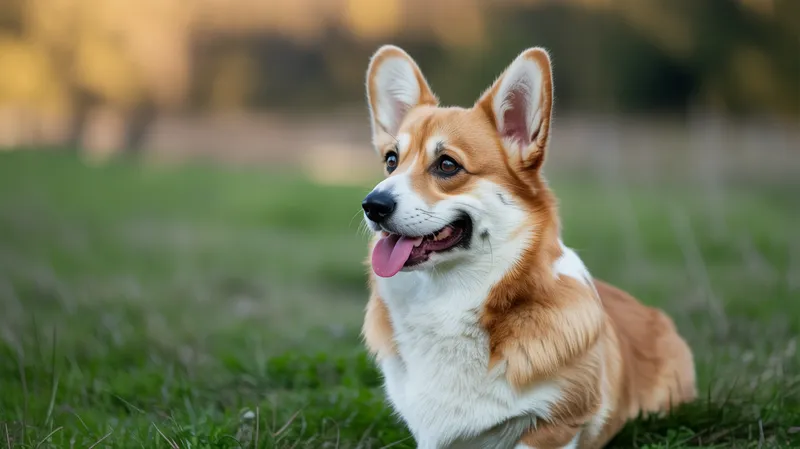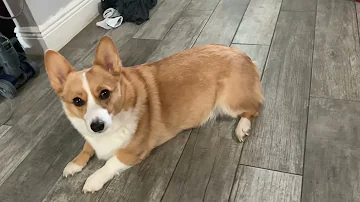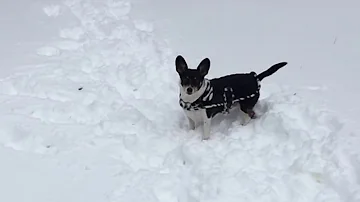
Corgi (Pembroke Welsh)
Canis lupus familiaris

Meet the Corgi (Pembroke Welsh)
The Pembroke Welsh Corgi is a small, sturdy herding dog breed originating from Pembrokeshire, Wales. Known for its distinctive short legs, fox-like face, and upright ears, this breed is renowned for its intelligence and affectionate nature. Pembroke Welsh Corgis are highly trainable, energetic, and make excellent companions as well as working dogs. Their cheerful disposition and adaptability have made them a favorite among families and even royalty.
Classification
Mammal
Habitat
Domestic (human homes, farms, and rural areas)
Diet
Omnivore
Lifespan
12-15 years
Conservation
Least Concern
Weight
10-14 kg (22-31 lbs)
📖Fascinating Facts
Royal Favorite
Queen Elizabeth II popularized the breed worldwide by keeping Pembroke Welsh Corgis as her personal pets for decades.
Herding Instinct
Pembroke Welsh Corgis were originally bred to herd cattle, and many still retain strong herding instincts today.
Fox-Like Appearance
Their pointed ears, expressive face, and bushy appearance often draw comparisons to foxes.
📋Detailed Description
The Pembroke Welsh Corgi is a compact, low-set herding breed, typically weighing 11–14 kg (24–30 lbs) and standing 25–30 cm (10–12 in) at the withers. Its elongated body, short but powerful legs, and deep chest are anatomical adaptations for agility and stamina, originally enabling it to nip at the heels of cattle while avoiding kicks. The breed’s double coat consists of a weather-resistant outer layer and a dense undercoat, providing insulation against the damp, cool climate of Wales. Corgis possess a keen, alert expression, with large, upright ears and a fox-like muzzle. Their tails are naturally short or docked—a distinguishing feature from the closely related Cardigan Welsh Corgi. Highly intelligent and eager to please, Pembrokes excel in obedience and canine sports. They are known for their sociable and affectionate demeanor, forming strong bonds with family members and displaying a pronounced herding instinct, sometimes directed toward children and other pets. Social structure within groups is typically cooperative, with clear hierarchies established through body language and vocalizations. Corgis are highly vocal, using a range of barks and yips to communicate. Their reproductive cycle is typical of domestic dogs, with females coming into estrus twice a year. Lifespan averages 12–15 years, with common health concerns including degenerative myelopathy and hip dysplasia. The breed’s adaptability and robust constitution have made it a favored companion and working dog worldwide.
💡 Did you know?
The Pembroke Welsh Corgi's name comes from its place of origin and the Welsh words 'cor' (dwarf) and 'gi' (dog), literally meaning 'dwarf dog.'
🔬Research & Sources
🎭Behavior & Social Structure
Pembroke Welsh Corgis are energetic and require regular physical and mental stimulation. Originally bred for herding, they retain strong instincts to chase and control movement, often seen in their tendency to herd people, other animals, or even moving objects. They are highly trainable, responding well to positive reinforcement and structured routines. Corgis are vigilant and make excellent watchdogs, quick to alert owners to unfamiliar sounds or visitors. Socially, they are affectionate with family but may be reserved with strangers. Playful and spirited, they enjoy interactive games, agility exercises, and problem-solving tasks. Feeding behavior is typical of omnivorous domestic dogs, with a tendency toward overeating if not monitored. Daily routines should include structured exercise, training sessions, and social interaction to prevent boredom and behavioral issues.
👶Reproduction & Life Cycle
Pembroke Welsh Corgis reach sexual maturity between 6–12 months, though responsible breeding is recommended after 18 months of age. Females experience estrus approximately twice yearly, each cycle lasting 2–3 weeks. Mating is typically arranged by breeders to ensure genetic health and temperament. Gestation lasts about 63 days, with litters averaging 6–8 puppies. Neonates are altricial, requiring extensive maternal care. Mothers nurse and clean the puppies, while breeders often assist with early socialization. Weaning begins at 3–4 weeks, with puppies fully weaned by 6–8 weeks. Breeding is generally not seasonal in domestic settings, though some breeders may time litters for optimal conditions. Responsible breeders screen for hereditary conditions such as progressive retinal atrophy and degenerative myelopathy.
🛡️Adaptations & Survival
The Pembroke Welsh Corgi’s low stature and elongated body are evolutionary adaptations for herding, allowing them to dodge kicks and maneuver beneath livestock. Their double coat protects against harsh weather, while their strong, muscular hindquarters provide speed and agility. Behavioral adaptations include acute intelligence, problem-solving ability, and a strong drive to work cooperatively with humans. Their vocalizations serve as both communication and deterrent. Social flexibility allows them to integrate into human households or work in teams with other dogs. Their keen senses of hearing and smell are well-developed, aiding in both herding and watchdog roles.
📚Research Sources
🎨Cultural Significance
The Pembroke Welsh Corgi holds a prominent place in Welsh folklore, often depicted as the preferred mount of fairy warriors. In modern times, the breed is famously associated with the British royal family, particularly Queen Elizabeth II, who has owned more than 30 Pembroke Corgis since childhood. This royal connection has elevated the breed’s status globally, leading to frequent appearances in media, literature, and art. Corgis are celebrated in festivals and parades, and their image is used in merchandise and popular culture. Historically, they were valued as efficient herding dogs on Welsh farms, contributing to rural economies.
🔬Recent Research & Discoveries
Recent genetic studies have clarified the relationship between the Pembroke and Cardigan Welsh Corgis, confirming distinct lineages despite superficial similarities. Research into breed-specific health issues, such as degenerative myelopathy, has identified genetic markers, enabling breeders to reduce incidence through DNA testing. Studies on canine cognition have highlighted the Corgi’s advanced problem-solving skills and social intelligence. Ongoing research focuses on optimizing breeding practices to maintain genetic diversity and reduce hereditary diseases. Behavioral research has also examined the breed’s herding instincts and adaptability to urban environments.
🎥Wildlife Videos

Nature documentary- Corgi’s environment
This is a nature documentary about the lifestyle of my families corgi dogs. If you want to see more please like, subscribe, and click ...
V1de0_J0urn1es

Nonsense Documentaries — Corgi
In this "documentary", we take a look at a magnificent animal, called Corgi. This video is a compilation of funny clips found around ...
Nonsense Documentaries

When a Corgi Can't Walk, Her Owner Finds a Set of Wheels | BarkFest
Opal has degenerative myelopathy, a disease that prevents her from using her legs but that has not deterred her nor her forever ...
Nat Geo Animals

Corgi Pups Explore The World On Their Tiny Legs | Too Cute!
Exploring a great big house can be tough when you're a puppy, especially when you have tiny corgi legs! But these curious pups ...
Animal Planet

Kallie Nielsen and National geographic presents: Corgis
This is for an assignment for my graduate degree program: Design Thinking at Radford University. Its a comical representation of ...
Kallie Nielsen (CorgiMom30)

Corgis: The Loyal, Playful, and Charming Companions | Wildlife Documentary | Fusion Documentary
Corgis: The Loyal, Playful, and Charming Companions | Wildlife Documentary | Fusion Documentary.
Fusion Documentary
🌍Habitat Information
The Corgi (Pembroke Welsh) typically inhabits Domestic (human homes, farms, and rural areas) environments. Corgi (Pembroke Welsh)s have adapted to their environments with specialized features and behaviors.
Primary Habitat:
Domestic (human homes, farms, and rural areas)
More detailed habitat information will be available soon.
🛡️Conservation Status
The Corgi (Pembroke Welsh) is currently classified as Least Concern. Conservation efforts are crucial for preserving this species for future generations.
Common Threats:
- 🏠Habitat loss and fragmentation
- 🌡️Climate change impacts
- 🎯Hunting and poaching
- 🏭Human-wildlife conflict
⚠️Threats & Conservation Challenges
As a domestic breed, Pembroke Welsh Corgis face few natural threats, but are susceptible to health challenges such as intervertebral disc disease, hip dysplasia, and obesity. Overbreeding and popularity-driven breeding practices have led to increased incidence of hereditary disorders. Lack of exercise and mental stimulation can result in behavioral problems and reduced quality of life. While not threatened in the wild, the breed's genetic diversity is a concern among responsible breeders. Human impact is generally positive, with strong breed clubs and health screening protocols, but trends in cosmetic breeding (e.g., tail docking) remain controversial. Population trends are stable, with the breed maintaining popularity in Europe, North America, and Asia.
🔬Scientific Classification
Scientific Name
Canis lupus familiaris
Classification Hierarchy
🔍 About Taxonomic Classification
Taxonomic classification is a hierarchical system used by scientists to classify and organize living organisms based on shared characteristics and evolutionary relationships.
The system moves from broad categories (Kingdom) to increasingly specific ones, with each animal's scientific name typically consisting of its Genus and species.
📝Community Notes
Share your observations and insights about the Corgi (Pembroke Welsh) with our community of wildlife enthusiasts.
Join Our Community
Sign in to share your observations and connect with fellow wildlife enthusiasts.
Sign In to ContributeNo community notes yet
Be the first to share your observations about the Corgi (Pembroke Welsh)!
Explore Corgi (Pembroke Welsh)
Select a tab above to learn more about this amazing animal.
📸Photo Gallery
No photos available for this animal yet.
🌟Discover More Wildlife
Continue your journey of discovery with more fascinating animals from our database
